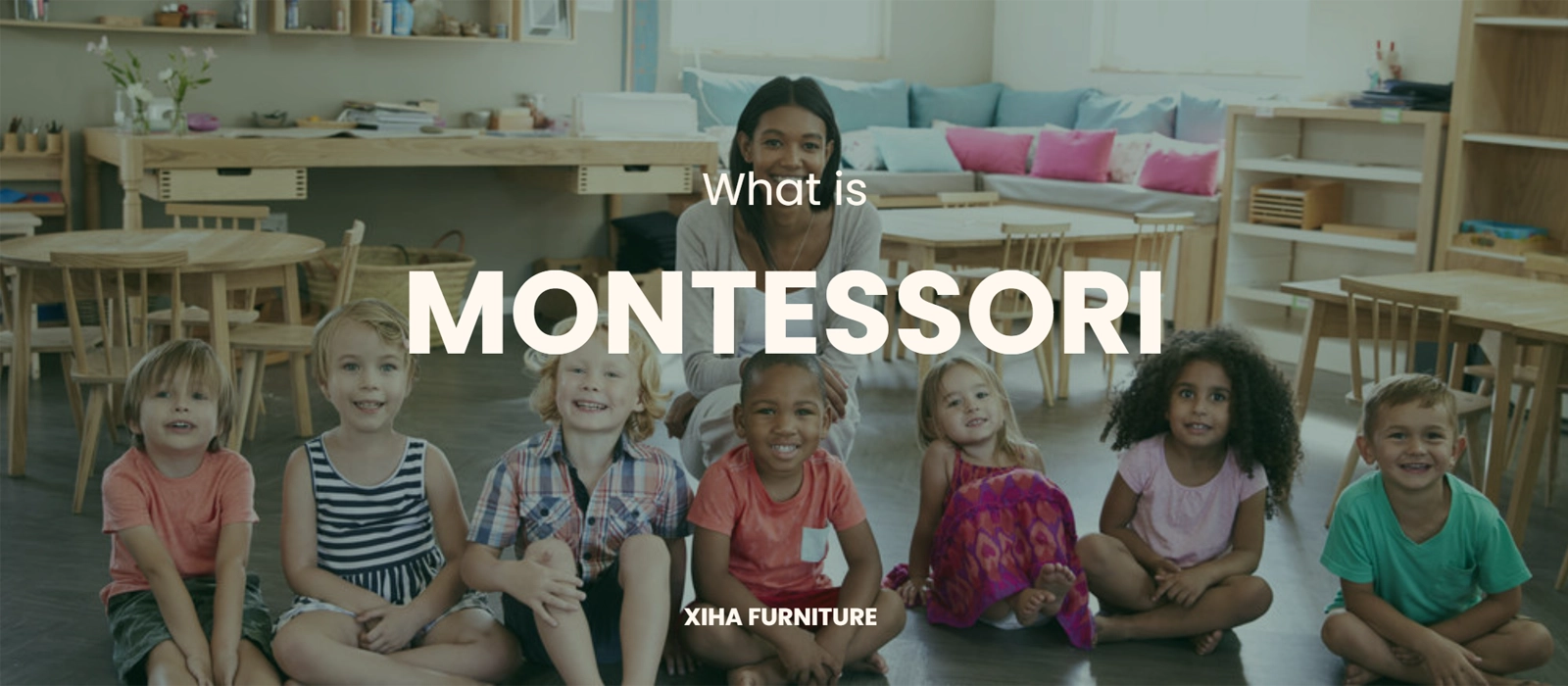Have you ever wondered what Montessori is and how it differs from traditional education? Are you curious about why so many educators, parents, and schools have embraced the Montessori method? What sets Montessori apart from other educational philosophies? How can this method shape your child’s future and help them develop essential life skills?
The Montessori method is an educational approach that places the child at the center of their learning journey. It emphasizes independence, hands-on experiences, and respect for the natural development of each child. But what is Montessori really about, and how does it work? In this article, we will dive deep into the core principles of Montessori, its key benefits, and why it continues to have such a profound impact on educational systems worldwide. By the end, you will have a clear understanding of what Montessori is and whether it might be the right fit for your child.
Let’s explore the essence of Montessori and see how it transforms the way children learn and grow.
What is Montessori?
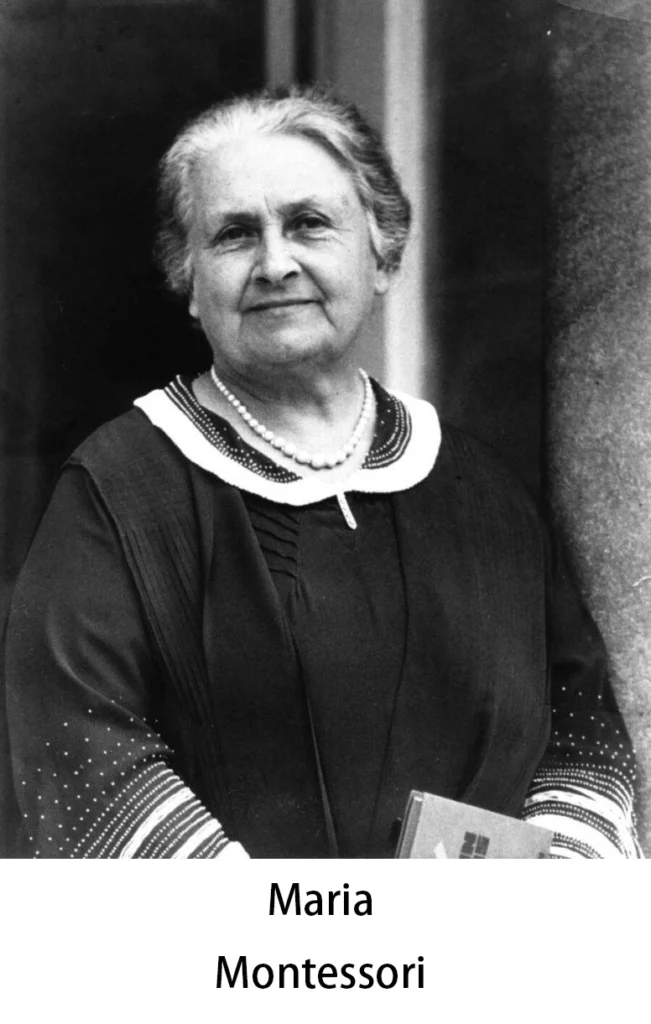
Montessori is a child-centered educational method that has been revolutionizing the way children learn for over a century. Developed by Dr. Maria Montessori in the early 1900s, this approach focuses on fostering independence, respect for the child’s natural development, and hands-on learning experiences. The core idea behind Montessori is that children learn best when they are given the freedom to explore and discover at their own pace, within a carefully prepared environment that supports their developmental needs.
But what is Montessori, and why has it gained such widespread recognition and popularity? At its core, Montessori is a philosophy that places the child at the center of the learning process. Unlike traditional education, which is often teacher-directed and structured, Montessori encourages children to take responsibility for their own learning, explore their interests, and engage with the world around them in a meaningful way.
In a Montessori classroom, children are given the freedom to choose their activities, work at their own pace, and collaborate with their peers. The teacher, in this environment, acts as a guide rather than a traditional instructor, helping children to explore their interests, make connections, and deepen their understanding of the world. This approach fosters not only academic success but also a love of learning, self-motivation, and a sense of personal responsibility.
So, what is Montessori all about? It’s about creating a learning environment where children are empowered to be active participants in their own education. It’s about recognizing that every child is unique, and that learning should be individualized to meet their specific developmental needs. And it’s about fostering a sense of independence, curiosity, and self-direction that will serve children well throughout their lives.
Let’s dive deeper into the core principles of Montessori and explore how this unique approach works to support children’s growth and development.
Key Principles of Montessori
The Montessori method is built upon five core principles that set it apart from other educational approaches. These principles guide both the design of the learning environment and the way teachers interact with students, fostering an atmosphere that nurtures independence, curiosity, and a deep love for learning. Let’s explore each of these principles in more detail:
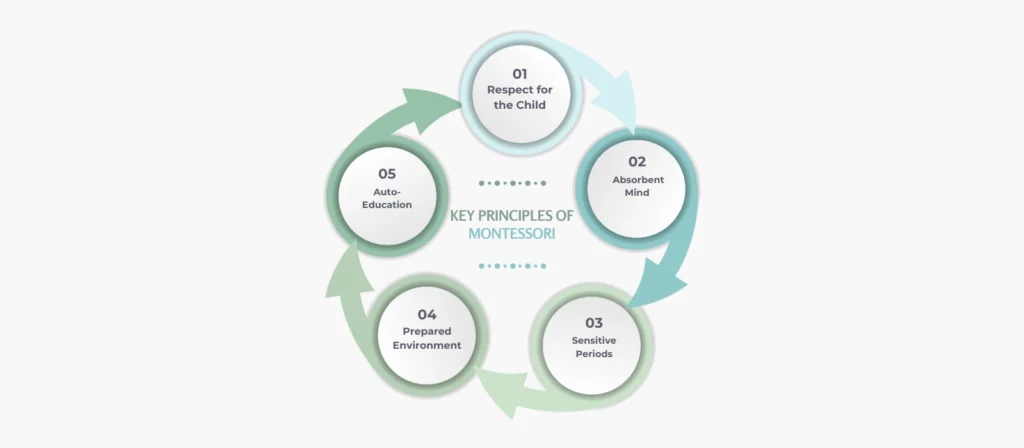
Principle 1: Respect for the Child
One of the most fundamental aspects of Montessori education is respect for the child. In a Montessori environment, children are viewed as capable and active participants in their learning process. The teacher treats each child with respect and dignity, acknowledging their unique needs, abilities, and developmental stages. This respect fosters a sense of trust and encourages children to take responsibility for their own learning. The idea is that when children feel respected and valued, they are more likely to develop self-confidence and become intrinsically motivated to learn.
Respect for the child also extends to the learning materials and the classroom environment. Montessori classrooms are designed to be accessible and supportive of children’s independence, allowing them to make choices about their work and their environment. The teacher’s role is to observe, guide, and facilitate, but never to impose their will on the child. This respect for the child’s autonomy helps build a sense of independence that is crucial for lifelong learning. What is Montessori without respect for the child? It is at the core of the Montessori method.
Principle 2: Absorbent Mind
The concept of the absorbent mind refers to the extraordinary ability of young children to take in information and experiences from their environment during their early years. Dr. Montessori recognized that children under the age of six possess a remarkable capacity to learn effortlessly and unconsciously, absorbing everything around them. This period of rapid learning is known as the absorbent mind phase.
In Montessori education, this principle is taken into account when designing the learning environment. The materials in a Montessori classroom are carefully chosen to stimulate the child’s senses and engage them in meaningful, hands-on learning experiences. The idea is that children naturally absorb knowledge from their surroundings, and it is essential to provide them with a rich, engaging environment that nurtures their natural curiosity. So, what is Montessori without considering the absorbent mind? It is incomplete.
Principle 3: Sensitive Periods
Sensitive periods are specific windows of time during which a child is particularly receptive to learning certain skills or concepts. These periods are characterized by an intense focus on particular developmental tasks, such as language acquisition or learning to coordinate movement. During these sensitive periods, children are highly motivated to engage in certain types of activities, and they learn more easily and quickly.
Montessori education takes advantage of these sensitive periods by offering children the right materials and activities at the right time. For example, young children may be naturally drawn to sorting and classifying objects, which is an activity that helps develop their cognitive skills. By observing and understanding the sensitive periods of each child, Montessori educators can tailor the learning experience to match the child’s developmental stage, providing optimal opportunities for growth. In Montessori, recognizing sensitive periods helps to fully unlock a child’s potential—what is Montessori if not attuned to these crucial developmental windows?
Principle 4: Prepared Environment
The prepared environment is a central concept in Montessori education. It refers to the physical and social space in which learning takes place, and it is carefully designed to support the child’s development. In a Montessori classroom, the environment is organized, orderly, and designed to promote independence and freedom of choice. All materials are placed at the child’s level, allowing them to choose activities that align with their interests and developmental needs.
The prepared environment also extends beyond the classroom itself. It includes the social and emotional atmosphere of the classroom, where respect, cooperation, and empathy are fostered. The teacher plays a key role in preparing the environment, ensuring that it is conducive to learning and supports the child’s growth and independence. What is Montessori without a prepared environment? It is a place that lacks the structure needed to facilitate the child’s independence and growth.
Principle 5: Auto-Education
Auto-education, or self-directed learning, is a cornerstone of the Montessori approach. This principle emphasizes the child’s ability to educate themselves through their own exploration and discovery. Montessori materials are designed to be self-correcting, allowing children to learn from their mistakes and find solutions independently. The teacher’s role is not to provide answers, but to guide the child in their journey of discovery.
Through auto-education, children develop a sense of responsibility for their own learning. They become active participants in the learning process, gaining confidence in their ability to solve problems and make decisions. This principle helps children develop the skills they need to become lifelong learners who are motivated by curiosity and the desire to learn, rather than external rewards or pressure. What is Montessori without auto-education? It is a method that does not empower children to take charge of their own learning.
These five core principles form the foundation of the Montessori method and help create a unique learning environment that fosters independence, self-motivation, and a lifelong love of learning. By respecting the child, understanding the absorbent mind, recognizing sensitive periods, preparing the environment, and promoting auto-education, Montessori education provides children with the tools they need to grow, explore, and reach their full potential.
How Montessori Works in the Classroom
Now that we’ve explored the key principles of Montessori education, let’s take a closer look at how these principles manifest in the classroom setting. Montessori classrooms are quite different from traditional classrooms in terms of structure, layout, and the role of the teacher. Understanding how Montessori works in practice will help you see how these principles are brought to life in a way that encourages children to become independent, self-motivated learners. And for many Montessori schools around the world, including those we collaborate with at XIHA Furniture, the classroom is equipped with top-quality Montessori furniture designed to support these educational practices.
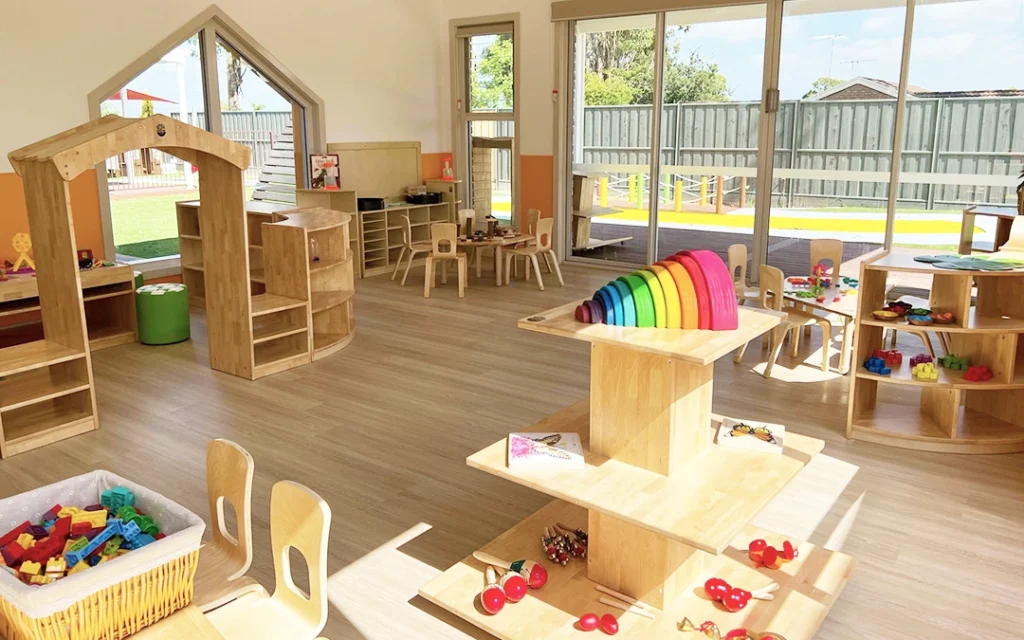
The Structure of a Montessori Classroom
A Montessori classroom is designed to be a carefully prepared environment where children can freely choose their activities and engage in self-directed learning. Unlike traditional classrooms where desks are often arranged in rows, a Montessori classroom is typically set up with various activity areas that cater to different learning domains. These areas might include sections dedicated to practical life activities, sensorial exploration, mathematics, language, and cultural studies.
The classroom is usually divided into learning stations, each designed with a specific set of materials that encourage children to explore concepts in a hands-on, self-correcting manner. For example, children might use tactile materials to learn math concepts like addition and subtraction or engage in language activities that help develop their vocabulary and reading skills. These materials are often multi-sensory, engaging the child’s sense of touch, sight, and sometimes even sound, to deepen the learning experience. At XIHA Furniture, we provide Montessori furniture that ensures these learning materials are safely and easily accessible, supporting the flow of the classroom.
The Role of the Teacher
In a Montessori classroom, the role of the teacher is drastically different from the traditional teacher’s role. Instead of being the central figure in the room who provides direct instruction, the Montessori teacher acts as a guide or facilitator. The teacher’s job is to observe the children, identify their interests, and offer guidance and resources to support their learning. The teacher also creates an environment that fosters independence and encourages children to take ownership of their learning journey.
Rather than providing direct answers, Montessori teachers encourage children to explore and discover on their own. When a child encounters a problem or challenge, the teacher may ask leading questions or offer subtle hints to help the child arrive at the solution independently. This approach helps develop critical thinking and problem-solving skills, as children learn to rely on their own abilities to solve problems and make decisions. At XIHA Furniture, we understand the importance of providing teachers with high-quality Montessori furniture to create the best possible learning environment.
Freedom of Choice and Movement
One of the most distinct features of a Montessori classroom is the freedom of choice and movement given to the children. In a Montessori environment, children are encouraged to move around the classroom, choose their own activities, and work at their own pace. This freedom helps children develop a sense of responsibility and self-discipline, as they learn to make decisions about what activities to engage in and how to manage their time.
Children are also free to move around the classroom, interacting with materials and peers. This active learning style encourages physical engagement with the environment and helps children develop coordination and motor skills. Additionally, the freedom to choose activities promotes autonomy, as children are empowered to make decisions that reflect their interests and learning needs. At XIHA Furniture, we provide Montessori classrooms with furniture designed for freedom of movement, helping children to engage more fully with their learning process.
Collaboration and Peer Learning
While Montessori classrooms allow for individual work and independent learning, they also encourage collaboration and peer learning. Children of different ages work together in the same classroom, allowing younger children to learn from older peers and vice versa. This mixed-age grouping fosters a sense of community and cooperation, as children learn to share, communicate, and support one another.
The collaborative environment also helps children develop important social skills, such as empathy, conflict resolution, and teamwork. Children learn to appreciate diversity and develop respect for one another’s ideas and perspectives, building strong relationships in the process.
In a Montessori classroom, collaboration is not just about working together on projects; it is also about sharing knowledge and helping each other grow. This peer-learning environment fosters an inclusive and supportive atmosphere where children can thrive academically and socially.
Self-Correction and Independent Learning
One of the key features of a Montessori classroom is the emphasis on self-correction. Montessori materials are designed to be self-correcting, meaning that children can check their work and identify mistakes without the need for adult intervention. This encourages children to take ownership of their learning and develop problem-solving skills.
For example, in math, children might use wooden blocks to visualize mathematical concepts such as addition, subtraction, and multiplication. If they make a mistake, they can often identify it by the arrangement of the blocks, and they will learn how to correct it independently. This process of self-correction fosters confidence and resilience, as children learn that mistakes are an important part of the learning process.
Self-correction also encourages independent thinking. Instead of relying on a teacher to provide the correct answer, children are empowered to think critically and reflect on their work. This process promotes a deep understanding of concepts, as children are actively engaged in the learning process and are given the opportunity to correct and refine their understanding of the material.
In conclusion, Montessori classrooms are designed to support independent, hands-on learning that encourages children to take ownership of their educational journey. Through a carefully prepared environment, a role shift for the teacher, freedom of movement and choice, peer learning, and self-correction, Montessori education provides children with the tools they need to become independent, responsible learners who are motivated by curiosity and a love of learning. At XIHA Furniture, we are proud to support Montessori schools by providing high-quality furniture that enhances the classroom environment and supports these important educational practices.
How Montessori Works in the Classroom
Now that we’ve explored the key principles of Montessori education, let’s take a closer look at how these principles manifest in the classroom setting. Montessori classrooms are quite different from traditional classrooms in terms of structure, layout, and the role of the teacher. Understanding how Montessori works in practice will help you see how these principles are brought to life in a way that encourages children to become independent, self-motivated learners. So, what is Montessori in the classroom, and how does it work in practice? For many Montessori schools around the world, including those we collaborate with at XIHA Furniture, the classroom is equipped with top-quality Montessori furniture designed to support these educational practices. What is Montessori in terms of its classroom setting? It’s an environment that fosters both independence and creativity.
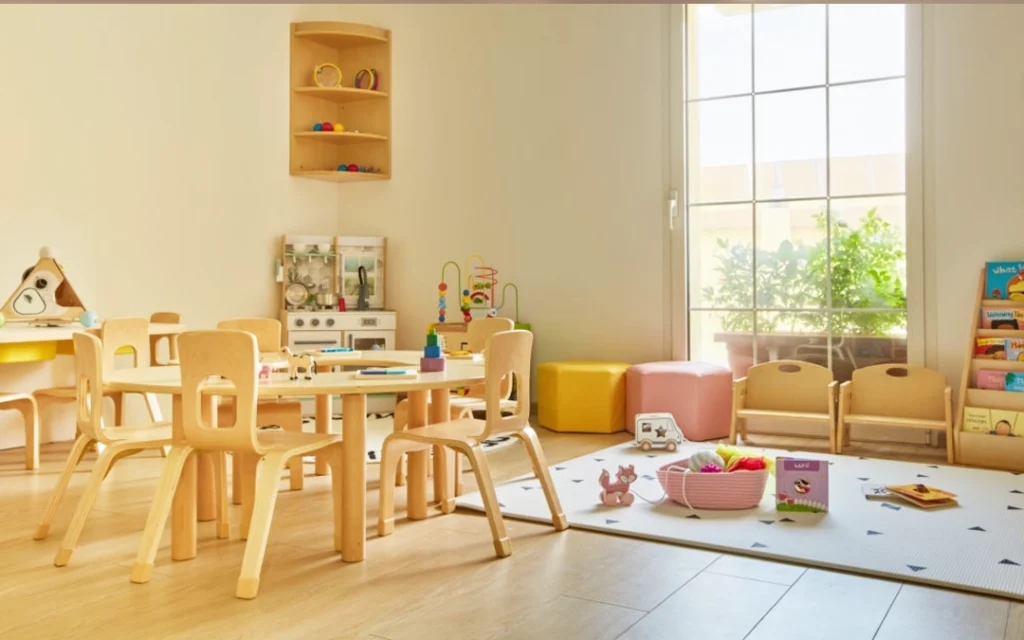
The Structure of a Montessori Classroom
A Montessori classroom is designed to be a carefully prepared environment where children can freely choose their activities and engage in self-directed learning. Unlike traditional classrooms where desks are often arranged in rows, a Montessori classroom is typically set up with various activity areas that cater to different learning domains. These areas might include sections dedicated to practical life activities, sensorial exploration, mathematics, language, and cultural studies. But what is Montessori in terms of classroom structure? It’s all about creating spaces that encourage exploration and independence.
The classroom is usually divided into learning stations, each designed with a specific set of materials that encourage children to explore concepts in a hands-on, self-correcting manner. For example, children might use tactile materials to learn math concepts like addition and subtraction or engage in language activities that help develop their vocabulary and reading skills. These materials are often multi-sensory, engaging the child’s sense of touch, sight, and sometimes even sound, to deepen the learning experience. What is Montessori without these hands-on materials? They are the cornerstone of the learning process.
The Role of the Teacher
In a Montessori classroom, the role of the teacher is drastically different from the traditional teacher’s role. Instead of being the central figure in the room who provides direct instruction, the Montessori teacher acts as a guide or facilitator. So, what is Montessori in terms of the teacher’s role? It’s about shifting the focus from teaching to guiding and observing.
The teacher’s job is to observe the children, identify their interests, and offer guidance and resources to support their learning. The teacher also creates an environment that fosters independence and encourages children to take ownership of their learning journey. Rather than providing direct answers, Montessori teachers encourage children to explore and discover on their own. When a child encounters a problem or challenge, the teacher may ask leading questions or offer subtle hints to help the child arrive at the solution independently. This approach helps develop critical thinking and problem-solving skills, as children learn to rely on their own abilities to solve problems and make decisions. At XIHA Furniture, we understand the importance of providing teachers with high-quality Montessori furniture to create the best possible learning environment.
Freedom of Choice and Movement
One of the most distinct features of a Montessori classroom is the freedom of choice and movement given to the children. In a Montessori environment, children are encouraged to move around the classroom, choose their own activities, and work at their own pace. This freedom helps children develop a sense of responsibility and self-discipline, as they learn to make decisions about what activities to engage in and how to manage their time. But what is Montessori without the freedom of choice and movement? This freedom is essential to the Montessori philosophy.
Children are also free to move around the classroom, interacting with materials and peers. This active learning style encourages physical engagement with the environment and helps children develop coordination and motor skills. Additionally, the freedom to choose activities promotes autonomy, as children are empowered to make decisions that reflect their interests and learning needs. At XIHA Furniture, we provide Montessori classrooms with furniture designed for freedom of movement, helping children to engage more fully with their learning process.
Collaboration and Peer Learning
While Montessori classrooms allow for individual work and independent learning, they also encourage collaboration and peer learning. Children of different ages work together in the same classroom, allowing younger children to learn from older peers and vice versa. This mixed-age grouping fosters a sense of community and cooperation, as children learn to share, communicate, and support one another. What is Montessori in terms of peer learning? It’s about fostering a sense of cooperation and respect.
The collaborative environment also helps children develop important social skills, such as empathy, conflict resolution, and teamwork. Children learn to appreciate diversity and develop respect for one another’s ideas and perspectives, building strong relationships in the process.
In a Montessori classroom, collaboration is not just about working together on projects; it is also about sharing knowledge and helping each other grow. This peer-learning environment fosters an inclusive and supportive atmosphere where children can thrive academically and socially.
Self-Correction and Independent Learning
One of the key features of a Montessori classroom is the emphasis on self-correction. Montessori materials are designed to be self-correcting, meaning that children can check their work and identify mistakes without the need for adult intervention. So, what is Montessori in terms of self-correction? It’s a method that encourages children to independently identify and fix their mistakes.
For example, in math, children might use wooden blocks to visualize mathematical concepts such as addition, subtraction, and multiplication. If they make a mistake, they can often identify it by the arrangement of the blocks, and they will learn how to correct it independently. This process of self-correction fosters confidence and resilience, as children learn that mistakes are an important part of the learning process. What is Montessori without self-correction? It would be a method that does not empower children to learn from their own mistakes.
Self-correction also encourages independent thinking. Instead of relying on a teacher to provide the correct answer, children are empowered to think critically and reflect on their work. This process promotes a deep understanding of concepts, as children are actively engaged in the learning process and are given the opportunity to correct and refine their understanding of the material.
In conclusion, Montessori classrooms are designed to support independent, hands-on learning that encourages children to take ownership of their educational journey. Through a carefully prepared environment, a role shift for the teacher, freedom of movement and choice, peer learning, and self-correction, Montessori education provides children with the tools they need to become independent, responsible learners who are motivated by curiosity and a love of learning. At XIHA Furniture, we are proud to support Montessori schools by providing high-quality furniture that enhances the classroom environment and supports these important educational practices.
Benefits of Montessori Education
Montessori education has gained widespread recognition for its unique approach to learning, which fosters independence, creativity, and a deep love for learning. But what is Montessori in terms of its benefits for children? What makes this method so effective in promoting cognitive, social, and emotional growth?
Promoting Independence
One of the most significant benefits of Montessori education is that it encourages children to become independent and self-motivated learners. By allowing children the freedom to explore and choose their activities, Montessori provides an environment that nurtures independence and responsibility. So, what is Montessori’s role in promoting independence? It’s a method that empowers children to take ownership of their learning, building self-confidence and self-discipline.
Fostering Creativity and Critical Thinking
Montessori education also promotes creativity and critical thinking skills. Through hands-on learning, children engage with materials that require problem-solving and decision-making, encouraging them to think outside the box. What is Montessori in terms of fostering creativity? It’s about providing an environment where children are encouraged to explore their ideas, ask questions, and develop solutions independently.
Developing Social and Emotional Skills
Another key benefit of Montessori is the focus on social and emotional development. In Montessori classrooms, children of various ages interact with one another, learning to collaborate, communicate, and resolve conflicts. What is Montessori in terms of social and emotional growth? It’s a method that fosters empathy, respect, and cooperation, helping children develop strong interpersonal skills that will serve them well throughout their lives.
Encouraging Individualized Learning Pace
Additionally, Montessori classrooms are structured to allow children to work at their own pace, giving them the time and space they need to master concepts. What is Montessori in terms of pace and mastery? It’s an approach that recognizes the individual needs of each child, providing the freedom to progress at a comfortable pace while still challenging them to reach their full potential.
In conclusion, Montessori education offers a wealth of benefits that go beyond academic achievement. By fostering independence, creativity, social skills, and emotional growth, Montessori prepares children for success both in school and in life. What is Montessori? It’s a method that equips children with the tools they need to succeed academically and personally, helping them become lifelong learners who are motivated by curiosity, creativity, and a sense of responsibility.
Montessori vs. Traditional Education
| Aspect | Montessori Education | Traditional Education |
|---|---|---|
| Teaching Style | Self-directed learning, guided by the teacher | Teacher-directed, with a set curriculum |
| Classroom Structure | Flexible, open spaces, children move freely | Desks in rows, teacher is the central figure |
| Teacher’s Role | Guide and facilitator, observing and offering resources | Primary source of knowledge, delivers lessons |
| Student Autonomy | Children choose activities, work at their own pace | Students follow the teacher’s instructions |
| Focus of Learning | Encourages exploration and hands-on learning | Focus on standardized testing and academic outcomes |
| Approach to Independence | Promotes independence and responsibility | Limited independence, often dependent on teacher’s direction |
When comparing Montessori education to traditional methods, the differences become clear in terms of classroom structure, teaching style, and overall philosophy. But what is Montessori in comparison to traditional education? How does this unique approach differ from the conventional methods used in many schools around the world?
In traditional classrooms, teaching is often teacher-directed, and children are expected to follow a set curriculum. The focus is usually on standardized testing and measurable academic outcomes. In contrast, Montessori education emphasizes self-directed learning, where children are encouraged to explore subjects that interest them, work at their own pace, and learn through hands-on experiences. So, what is Montessori in terms of its focus on student autonomy? It’s a method that prioritizes the child’s intrinsic motivation and curiosity over external rewards and pressures.
Another key difference is the structure of the classroom. In traditional education, classrooms are often set up in rows with desks facing the front, where the teacher is the central figure in the room. This creates a more passive learning environment, with the teacher delivering information to the students. What is Montessori in terms of classroom layout? It’s a flexible, open space where children move freely, select activities, and collaborate with peers, making learning much more active and engaging.
The role of the teacher in Montessori education also differs significantly from that in traditional classrooms. In a traditional setting, the teacher is the primary source of knowledge, standing in front of the class and delivering lessons. However, in a Montessori classroom, the teacher’s role is to act as a guide, observing the child’s interests and offering resources to support their learning journey. What is Montessori in terms of the teacher’s role? It’s about guiding and facilitating, rather than directing and controlling.
Additionally, Montessori classrooms are designed to promote independence and personal responsibility. Children are encouraged to make decisions about what they want to learn and how they approach their tasks. What is Montessori’s approach to independence? It’s about giving children the freedom to choose their activities, helping them develop critical thinking, problem-solving, and time management skills.
In conclusion, what is Montessori in comparison to traditional education? It’s an approach that places the child at the center of the learning process, fostering independence, creativity, and self-motivation. While traditional education tends to focus on conformity and external rewards, Montessori nurtures a love of learning that lasts a lifetime, allowing children to become confident, curious, and independent individuals.
Montessori for Different Age Groups
Montessori education is often associated with early childhood learning, but what is Montessori in terms of its application for different age groups? The Montessori method is designed to be adaptable and beneficial for children across a wide range of ages, from toddlers to adolescents. Each developmental stage is met with a carefully tailored approach to learning, ensuring that children receive the right tools and guidance to succeed at every stage of their growth.
Montessori for Toddlers and Preschoolers
What is Montessori for younger children? In the early years, Montessori education focuses on fostering independence and the development of practical life skills. Toddlers and preschoolers are given opportunities to learn through sensory exploration, movement, and the development of fine and gross motor skills. The Montessori classroom for young children is a prepared environment where they can engage in activities such as pouring, sorting, and cleaning, which help them develop a sense of responsibility and confidence.
At this age, children are particularly sensitive to language acquisition, and the Montessori method encourages rich language exposure through storytelling, singing, and interaction with peers and teachers. What is Montessori in terms of language development for young children? It’s a method that nurtures their natural love for language and communication, helping them develop strong verbal skills.
Montessori for Elementary-Aged Children
As children enter elementary school, the Montessori method continues to emphasize self-directed learning, but the focus shifts to more complex academic subjects. In Montessori classrooms for elementary-aged children, the emphasis is placed on critical thinking, problem-solving, and exploration of the world around them. What is Montessori for older children? It’s a method that encourages children to dive deeper into subjects such as mathematics, science, history, and art, all while maintaining their sense of independence and curiosity.
The Montessori approach also allows for collaborative work among peers. Children learn not only from their teachers but from each other as well. What is Montessori in terms of collaboration? It’s a method that fosters teamwork and helps children develop social skills such as empathy, communication, and conflict resolution.
Montessori for Adolescents
What is Montessori for adolescents? As children transition into adolescence, the Montessori method continues to provide a framework for learning that promotes independence and responsibility. The adolescent Montessori environment emphasizes practical work, community involvement, and the development of leadership skills. Adolescents are encouraged to explore their own interests and pursue projects that align with their passions and career aspirations. What is Montessori in terms of preparing adolescents for adulthood? It’s a method that helps young people develop the skills they need to navigate the world confidently, from communication to problem-solving to leadership.
In conclusion, what is Montessori for different age groups? It is a method that adapts to the needs of children at every stage of their development. From toddlers to adolescents, Montessori provides a supportive and enriching environment that nurtures each child’s potential, preparing them for a lifetime of learning, exploration, and personal growth.
Montessori in a Global Context
Montessori education is widely recognized around the world, but what is Montessori’s global impact? Over the years, Montessori schools have expanded globally, with educators, parents, and communities embracing this child-centered approach. What is Montessori in terms of its reach? It’s a method that transcends geographical boundaries, adapting to different cultures and educational systems while maintaining its core principles.
What is Montessori’s role in global education? It’s a method that fosters a deep respect for diversity, helping children learn to appreciate different cultures and perspectives. Montessori schools around the world celebrate cultural differences, integrating global awareness into the curriculum. Through this global approach, children are encouraged to become responsible, empathetic global citizens, aware of their interconnectedness with others.
Montessori education also promotes international collaboration among educators. What is Montessori in terms of teacher collaboration? It’s a method that encourages teachers from different countries and educational backgrounds to share ideas and best practices, fostering a global network of Montessori educators. This collaboration ensures that Montessori methods are continually refined and improved, leading to better outcomes for children across the globe.
Another important aspect of Montessori’s global reach is its adaptability. What is Montessori in terms of adapting to different educational systems and cultures? It’s a method that can be implemented in diverse settings, whether in urban schools, rural areas, or international schools. Montessori’s flexibility allows it to be successfully integrated into various educational systems, making it a viable option for many families and communities worldwide.
In conclusion, what is Montessori in a global context? It’s a method that continues to grow and evolve, impacting children around the world by promoting independence, creativity, social responsibility, and respect for diversity. Montessori education is a powerful force in the global movement toward improving education for children of all backgrounds.
The Future of Montessori Education
As we’ve explored throughout this article, Montessori education is not only a proven method for children’s growth and development but also a flexible and adaptable approach that is gaining global recognition. So, what is Montessori’s future in education? How will this method continue to evolve in the coming years?
The future of Montessori education lies in its continued expansion and adaptation to meet the needs of modern children. As more schools around the world adopt Montessori principles, the method is expected to continue influencing educational systems and reshaping the way children learn. What is Montessori in terms of shaping the future of education? It’s a method that will continue to encourage children to become independent thinkers and lifelong learners, empowered by curiosity and a love of learning.
What is Montessori’s role in shaping future generations of students? It’s a method that prepares children to navigate the challenges of an ever-changing world. With an emphasis on critical thinking, creativity, and problem-solving, Montessori education equips children with the skills they need to adapt to future demands, both academically and in their personal lives.
Furthermore, as technology continues to play an increasing role in education, Montessori is evolving to integrate new tools and resources into the learning process. What is Montessori in terms of technology? It’s a method that embraces the use of technology in a balanced way, incorporating digital tools that enhance learning without overshadowing the hands-on, experiential approach that is core to the Montessori philosophy.
Another important aspect of Montessori’s future is the growing awareness of the importance of early childhood education. What is Montessori in terms of early education? It’s a method that recognizes the critical role of the early years in shaping a child’s future, and as more research highlights the benefits of early childhood education, the demand for Montessori programs is expected to rise.
In conclusion, what is Montessori in the future of education? It’s a method that will continue to inspire and shape future generations, providing children with the tools they need to succeed in an ever-evolving world. By focusing on independence, creativity, critical thinking, and social responsibility, Montessori education prepares children for success not only in school but in life.
Conclusion
In conclusion, what is Montessori? It’s an innovative and child-centered approach to education that empowers children to learn at their own pace, explore their natural curiosities, and become independent thinkers. Montessori education focuses not just on academic success, but also on the development of essential life skills such as critical thinking, social responsibility, and emotional intelligence.
As we’ve seen, Montessori’s key principles, such as respect for the child, the absorbent mind, and the prepared environment, make it a powerful method for fostering a love of learning and personal growth. With its focus on individualized learning, hands-on experiences, and peer collaboration, Montessori provides children with the tools they need to succeed in both their academic and personal lives.
At XIHA Furniture, we are proud to be part of the Montessori movement by providing high-quality furniture that enhances the Montessori classroom experience. Our furniture is designed to support the child’s need for independence, accessibility, and comfort, making the prepared environment a true asset to the Montessori method. By working closely with Montessori schools worldwide, we ensure that children have a well-equipped, safe, and stimulating environment to thrive in. What is Montessori without a carefully designed classroom environment? It’s a method that lacks the full potential to nurture the child’s growth and independence. We’re honored to contribute to this important educational approach and look forward to seeing more children benefit from the Montessori experience.

